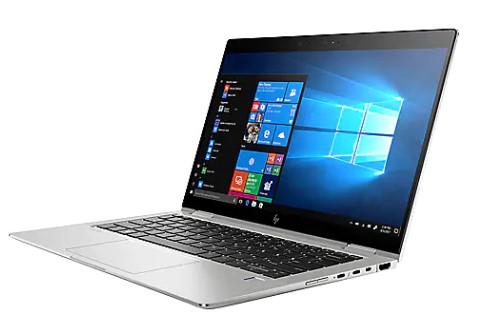Listen to Larry’s CBS News Radio Eye on Tech about these new laptops

I spend a fair amount of time on the road. When I’m traveling, I want a full-featured laptop that’s light enough to carry around all day.
That’s why several years ago I bought a MacBook Air, which gave me all the features I needed in a slim 3-pound chassis. I upgraded to new MacBook Air models a couple of times until I realized that Apple wasn’t keeping up with the competition.
In 2016, I switched to an HP Spectre, which had a similar design but was slightly lighter and thinner with better battery life, a touch-screen and the ability for the screen to bend completely back, allowing you to use the laptop in tablet mode. I was hooked, and my old Macbook Air has been sitting on a shelf ever since.
It took awhile, but on Tuesday, Apple announced a re-designed version of the MacBook Air.
In the meantime, HP has continued to innovate with new versions of its Spectre and even lighter and higher-performance versions of its business-oriented EliteBook series.
One difference between Apple and HP is that Apple has relatively few choices when it comes to laptops: The tiny MacBook, the somewhat larger new MacBook Air and a line of MacBook Pros. HP has an almost dizzying array of choices starting at under $600. Some are aimed at business and others aimed at consumers. The Spectre 360 series of high-end consumer laptops starts at about $949.
Like both the old and new MacBook Air, they have an all-aluminum body, but they also have a touch-screen and the ability to push the screen all the way back to use as a tablet. Sometimes I push it half way so it’s like a tent — perfect for watching movies. HP also does a great job when it comes to all-important battery life. The Spectre models, depending on configuration are rated for up to 16 hours, which means you can leave the house or hotel for the day without bothering to pack a charger.
HP’s EliteBook series looks similar to the Spectre, but they’re more rugged and have software and features aimed at business users. They’re also more expensive, starting at about $1,350. Both the Spectre and EliteBook have Bang and Olufsen audio, which sounds great when listening to music or a video soundtrack.
Hands-on new HP EliteBook

I wasn’t in New York for the MacBook Air unveiling, but I do have my hands on the newest HP EliteBook X360 G3, which also was announced this week. At 2.76 pounds and .62 inches, it’s essentially the same size and weight as Apple’s slightly slimmed down new MacBook Air, but a quarter-pound lighter than a MacBook Pro. In terms of price and performance, the EliteBook line is comparable to Apple’s MacBook Pro.
The MacBook Air starts at $1,199 for one with 8 GB of memory and only 128 GB of storage or $1,399 for 256 GB of storage. The newest HP EliteBook starts at $1,799 with 256 GB of storage and 8 GB of memory but has a newer generation Intel processor, and unlike the MacBook, it has a touch-screen and the ability to push the screen all the way back so it’s like a tablet. It also has a longer battery life.
HP claims 18 hours compared with 12 hours for the new MacBook Air. I didn’t measure it, but my review unit has power left over after using it on and off all day without recharging.
Memory, storage and screen resolution
The unit I’m testing has 512 GB of storage and 16 GB of memory and a very fast i7 processor, which is why it costs $2,250. HP offers options when it comes to displays including full high-definition (FHD) at 1920 x 1280 pixels and an ultra high resolution display (UHD) at 3840 x 2160 which is amazingly crisp, but draws more energy.
The company also has an optional Sure View display that serves as an electronic privacy screen that you can toggle on if, for example, you’re on a plane and don’t want the person behind or next to you seeing what’s on your screen. I’m fine with the quality of the FHD and appreciate the extra battery life.
The big deal about the new Apple MacBook Air is its Retinal display with a resolution of 2560-by-1600, which is higher resolution than HP’s FHD screen but lower than its optional UHD. By comparison, the new MacBook Air has 227 pixels per inch (ppi) compared with 331 ppi for the EliteBook’s UHD display and 166 ppi for HP’s FHD screen.
Apple also added fingerprint recognition to is MacBook Air but that — along with really fast facial recognition — is also on HP’s new machines. Apple has facial recognition on some iPhones and its newest iPad, but not on any Mac.
All Mac and high-end HP laptops have solid-state drives (SSD) that make a huge difference in performance by loading software and saving data almost instantaneously.
New iPad Pro
No Apple Mac has a touch screen, a screen that pushes back into tablet mode or an electronic privacy screen. What Apple does offer is its line of iPads, which do have touch screens and optional keyboards that pretty much make them a laptop that runs the same iOS operating system as the iPhone. For many users, that’s just fine, but some people need the types of programs only available on Macs and Windows.
Apple this week announced a new iPad Pro in both 11- and 12.9-inch sizes starting at $799 for the 11-inch and $999 for the 12.9 inch. Add $179 to $199 for the Smart Keyboard and another $129 if you want the stylus called Apple Pencil. A fully decked-out iPad with a keyboard, pencil and 1 TB of storage will cost $2,077 or $2,227 if you want LTE cellular connectivity, making it as expensive as a high-end laptop.
There will always be a battle between Mac and Windows enthusiasts that’s almost as partisan as our political divide, but I think both camps can agree that HP and Apple are making lightweight laptops great again.